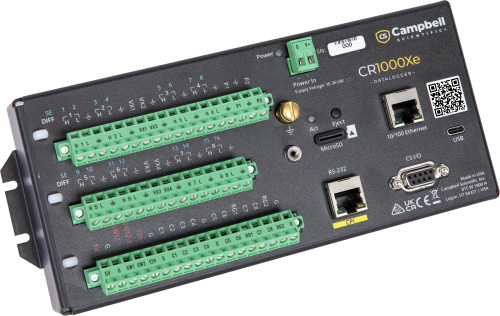Instrumentation
We offer a variety of products that can be used to create systems for Water Quality. Many of the major components used to create these systems are listed below. Please let us know if we can help you configure a system.
More Details about Our Water Quality Systems
Data Loggers Used in Water Quality Monitoring
Our data loggers feature wide operating temperature ranges, low power consumption, and the ability to directly interface with a large variety of sensors. Because our dataloggers operate on batteries (with or without solar panels), they are ideal for long-term, stand-alone operation, such as at remote streams or wells. Most of our data loggers are expandable using multiplexers and other peripherals. Data are typically displayed and stored in the desired units of measure (e.g., specific conductance as mS/m, µS/cm, Ohms).
Powerful on-board instruction sets allow unattended control decisions based on time or conditional events. For example, if measured water quality levels are outside a predetermined range, the data logger can actuate water samplers, sound alarms, open valves, actuate injectors, and make a phone call to report conditions. The data loggers can easily provide the necessary water sampler control to meet EPA-mandated first-flush and follow-up sample schedules. All data is time-stamped and data from event-triggered samples is marked for later analysis.
Water Quality Sensors
Almost any sensor, individual or multiparameter, may be used with the system, allowing the system to be customized for each application. We helped create the original SDI-12 standard, so you can be sure our systems are SDI-12 compatible. In addition, nearly all available flow, level, and meteorological sensors can be measured, generally without external signal conditioning.
Communications
The availability of multiple telecommunications and on-site options for retrieving data also allows systems to be customized to meet exact needs. Options include: voice-synthesized phone, telephone, cellphone, satellite, radio, ethernet, short haul, meteor burst, coaxial cable, and storage module. Systems can be programmed to send alarms or report site conditions by calling out to computers, phones, radios, or pagers. Real-time or historical data can be displayed or processed with Campbell Scientific software. Data can also be exported as ASCII files for further processing by spreadsheets, databases, or analysis programs.
Case Studies
The Port of Townsville Limited (POTL) are undertaking the Channel Upgrade Project (CU Project). The......read more
The Department of Science and Innovation (DSI) and its partners, including the Department of Basic......read more
The Jukskei River is one of the largest rivers in Johannesburg, South Africa. The river......read more
Steve Rodgers is the lab manager at the Aquaculture Research Center of the Institute of......read more
Steve Rodgers is the lab manager at the Aquaculture Research Center of the Institute of......read more
The Silkwood sugarcane water-quality monitoring site was established in 2014 as part of the Paddock......read more
Overview The existing port of Limon was constructed over 30 years ago. With the increase of......read more
Moving clean, cold water through a trout-rearing facility is essential to its success. A live......read more
Related Product Categories
Articles and Press Releases
Press Releases
- New Dual Backscatter/Sidescatter Turbidity Probe with Antifouling Features 16-06-2011
- Rugged, Non-Glass ISFET pH Probe for All pH Conditions 22-07-2009
- Campbell Scientific, Inc., Acquires OBS Product Line from D&A Instruments 20-03-2008
- Faster and Flexible: Campbell Scientific’s CR3000 Micrologger® 01-10-2005
- More Versatile Channels, Increased Memory: Campbell Scientific’s CR1000 Datalogger 06-09-2005
Privacy Policy Update
We've updated our privacy policy. Learn More
Customise a System
In addition to our standard systems available, many of the systems we provide are customised. Tell us what you need, and we’ll help you configure a system that meets your exact needs.











